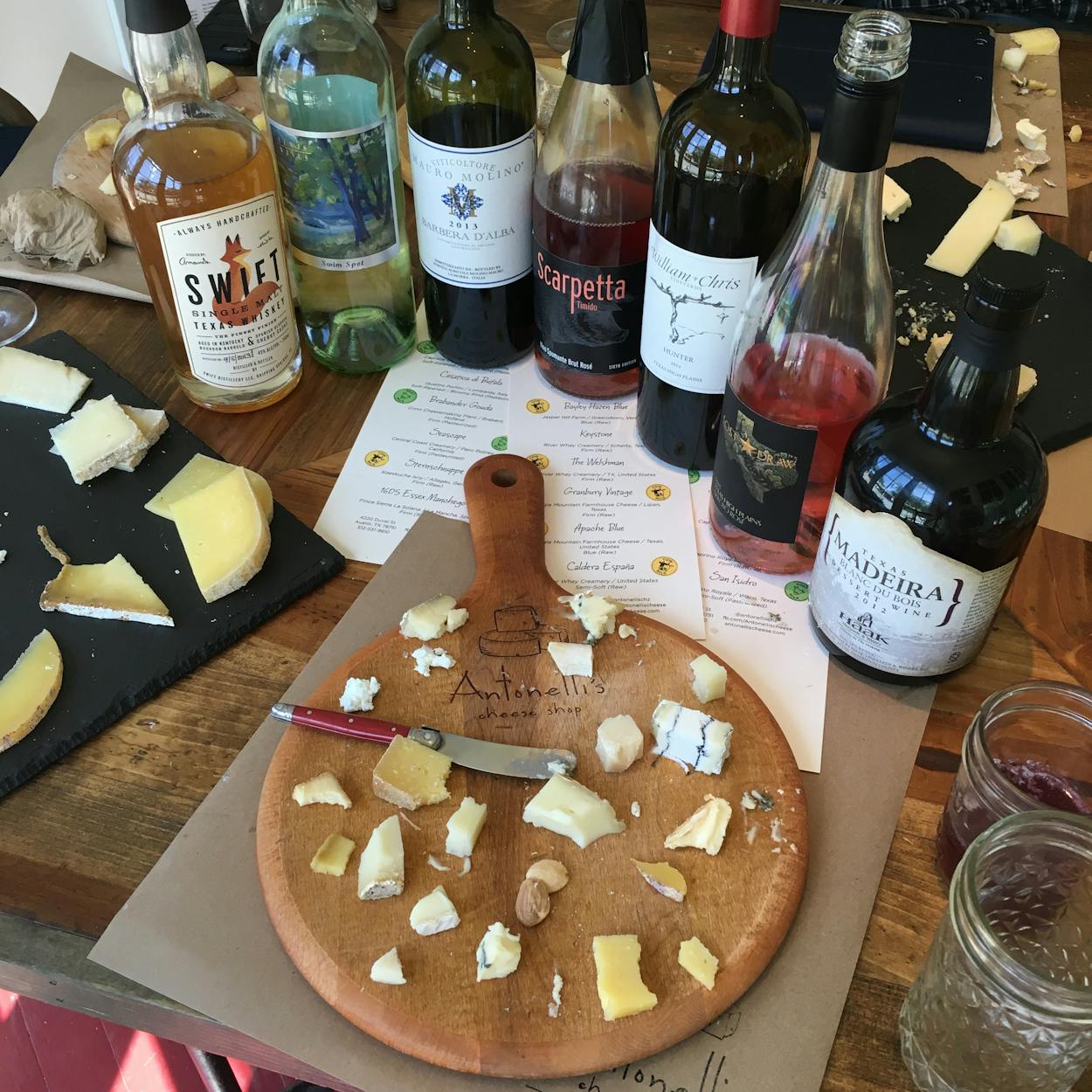I’ve never been one to turn down a cheese plate. Whether it be from the milk of cows, sheep, goat, or even water buffalo, I don’t discriminate when if comes to good cheese. In fact, I’ve often said my world would crumble—pardon the pun—if it turned out I was lactose intolerant. So when an opportunity to meet with John and Kendall Antonelli of Austin’s Antonelli’s Cheese House and get their tips on pairing wines with cheese, I was eager to accept. (If you’ve dined your way through any of Austin’s top restaurants, you’ve no doubt noticed that most of the cheese plate offerings on the menu are sourced from Antonelli’s Cheese Shop, a quaint little locale in the Hyde Park neighborhood with a long deli case filled with a sea of cheese from all over the world.)
Ready to scribble notes, I waited for John and Kendall to start firing off a list of do’s and don’ts. Yet some of the first words out of John’s mouth were something to the effect of, “When it comes to pairing cheese with wine, we throw out all the rules.”
I decided to put my pen down and just taste instead. The cheeses we sampled spanned the far corners of Europe’s best cheese-producing regions and hopped the pond to some of America’s best regions too. And of course, there was a sizable selection devoted to Texas cheese.
Of the wines we sampled all of them were from Texas—with the exception of an Italian sparkling rosé beauty by Scarpetta, which I was in no way disappointed to welcome into the mix.
Before tasting anything, John took us through an exercise he typically encourages with everyone new to cheese tasting. He presented a single Spanish Marcona almond to each of us. He asked us to hold our nose and just taste the almond without breathing in.
“It’s important to calibrate your palate before you start tasting,” said Antonelli. “When you hold your nose, and just chew the almond, you get the saltiness and buttery texture of the almond. When you release your nose and start inhaling, you get the savoriness along with components of bitterness and umami. The retronasal olfaction allows you to perceive odors from the mouth during eating and drinking rather than through sniffing. It helps focus your senses.”
From there, the best approach, the Antonellis say, is to sample and taste your way through cheeses with different wines and find out what your senses have to reveal to you.
“That’s when you start to zero in on things like how oaked white wines tend to be hard to pair with a lot of cheeses, or that big creamy cheeses with age, like Camembert, can take light red wines,” said Kendall Antonelli.
There are a few “safe bet” wine styles that the Antonelli’s always fall back on. “You can always count on sparkling wine and sweeter dessert wines with good acid. To work well with a lot of different cheeses,” said Antonelli. “Chenin Blanc is actually my favorite white grape for cheese. It’s like an iron fist with a velvet glove with lots of body. It drinks like a bigger wine, but has a lot of delicate nuances on the palate.”
When it comes to both cheese and wine, age is the key element that intensifies flavor. Without getting too scientific, it’s a simple factor of the natural chemistry in both cheese in wine, breaking down original components of each item and taking on new and more layered flavor profiles. In red wine, for instance, harsh tannins break down over time to reveal a smoother mouthfeel, while ripe fruit flavors of young red wines begin to take on nuances of stewed or dried fruits. With cheese, younger styles have more moisture and yield more creamy, delicate textures. As it ages, the natural water content evaporates and the stronger flavors of the fat and protein left behind create more savory, nutty characteristics—particularly with harder cheeses. Creamy, rind cheeses like brie or Camembert maintain moisture but take on earthy, mushroom flavors as they age. The moral of the story: you’ll automatically be on the right foot by pairing younger, fresher wines with younger, fresher cheeses, and older, more developed wines with older, more developed cheeses.
Young, soft cheeses work best with crisp, dry white or rosés or slightly chilled red wines with low tannin. Younger cheeses tend to carry nuances of lighter fruits and fresh herbs, so wines equal in freshness will generally work well for these. Note: For more herbaceous goat cheeses, opt for Sauvignon Blanc.
Try: Full Quiver Farms fresh Mozzarella with Infinite Monkey Theory 2015 Chenin Blanc or Pure Luck Chèvre with Spicewood Vineyards 2015 Sauvignon Blanc.
Semi-hard cheeses have a little more depth of flavor and can take on more medium-bodied whites and reds.
Try: Veldhuizen Cheese Shoppe Greens Creek Gruyere with Pedernales Cellars 2015 Viognier or McPherson Cellars 2015 Cinsault.
Aged creamier cheese such as older brie or taleggio need a red wine with some tannin and similar earthy qualities like mushroom and tobacco, like Texas Tempranillos.
Try: Brazos Valley Cheese Brie with Lewis Wines 2012 Parr Vineyard Tempranillo.
Blue cheese needs a wine that can calm down the robust flavors and salty characteristics. Instead of making the wine compete, opt for sweeter, aged wines wines that complement instead.
Try: Mozzarella Company Deep Ellum Blue cheese with 2013 Haak Vineyards and Winery Blanc du Bois Madeira.
Harder, aged cheeses tend to have fatty protein as well as nutty and salty qualities making them perfect for bigger, tannic wines as well as full-bodied sweet wines such as port.
Try: Veldhuizen Cheese Shoppe Double Barrel Cheddar with Brennan Vineyards 4.0 Cellars 2015 Montepulciano or Messina Hof Paulo Port.






